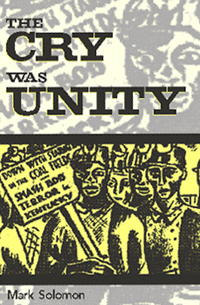 THE CRY WAS UNITY: Communists and African Americans, 1917-1936 by Mark Solomon BUY THIS BOOK |
Mark Solomon’s account of the troubled alliance between blacks and Communists in the years between the wars is much more than a meticulous study of racial and social protest. For Solomon, a long-time civil rights activist (and leading member of the left-wing Committees of Correspondence), writing The Cry Was Unity was an act of moral witness. In a time when Presidential apologies are tendered for slavery; when “market-based solutions” and “black entrepreneurialism” are offered as remedies for poverty and racism; when pleas for healing and reconciliation make no call for justice, Solomon’s history reminds us that pleas, apologies, and other half-measures are never enough. Those whose lives he eloquently describes — the black Communists who organized sharecroppers in Alabama, led hunger marches in Harlem, and battled evictions in Washington — didn’t deal in pleas and apologies. Their militant faith supplied them with a more potent arsenal.
Solomon, a retired professor of history at Simmons College, begins his story in 1917. With admirable skill, he traces the often-tortuous evolution of the Communist Party’s relations with black Americans over the following two decades. The first of his book’s three sections focuses on the “colorblind” phase of Communist policy, when party leaders largely ignored the “complications” of race, preferring to believe that racism was merely a reflection of “class bondage.” The second, beginning in 1928, focuses on the party’s ultra-revolutionary Third Period, when black Americans were not only recognized by the Party as a “national minority,” but guaranteed “self-determination” in the “Black Belt” of the Deep South. The last section ends with the launching of the party-led National Negro Congress in 1936 — a triumph of Popular Front policy that marked the high tide of the party’s aspirations for inter-racial unity.
Solomon offers a detailed portrait of Cyril Briggs, perhaps the most remarkable of the men and women featured in his pages. A Caribbean expatriate whose enemies dubbed him the “Angry Blond Negro” — he was, in fact, the son of an overseer on a Nevis Island plantation — Briggs was a pioneer Communist. Briggs organized the revolutionary African Black Brotherhood in 1919. He scorned the tactics of peaceful integration and spurned the appeals of Marcus Garvey’s “Back-to-Africa” movement. His Brotherhood merged the politics of racial pride with those of social revolution. Its broadsides called for black self-determination — an independent black republic, whether in Africa or the American South — and an alliance of all workingmen, black and white, against the forces of capitalism.
Briggs steered the Brotherhood — whose ranks swelled after the burning and pillaging of Tulsa’s black community in 1921 — toward alignment with the newly-organized Communist Party. He became a leading figure in the party’s higher councils during the febrile Third Period, and orchestrated a campaign to purge “white chauvinism” from the party’s ranks. His newspaper, TheHarlem Liberator, headlined the party’s anti-lynching drives. When nine black youths were accused of raping two white women on a Memphis-bound train in 1931, he fixed The Liberator’s sights on the struggle to save the Scottsboro Boys. He made The Liberator a vehicle for the promotion of a “genuine Negro culture” — a culture reflecting, in its songs of work and songs of revolt, “the struggles of a people for freedom [and] national liberation.”
In his portraits of Cyril Briggs and other party activists, Solomon has produced a moving story of defiance and rebellion. The perseverance they displayed should remind us, as Solomon says in his final chapter, that “the fight is not over, and the craving and the cry for unity are not extinguished.”
Dean Ferguson is an editor of Transformation, a newly launched literary journal. He lives and works in San Francisco.
|
| Print
